
Firs are evergreen coniferous trees belonging to the genus Abies in the family Pinaceae. There are approximately 48–65 extant species, found on mountains throughout much of North and Central America, Europe, Asia, and North Africa. The genus is most closely related to Cedrus (cedar).
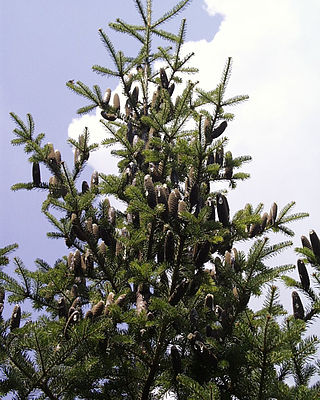
Abies balsamea or balsam fir is a North American fir, native to most of eastern and central Canada and the northeastern United States.

Abies nordmanniana, the Nordmann fir or Caucasian fir, is a fir indigenous to the mountains south and east of the Black Sea, in Turkey, Georgia and the Russian Caucasus. It occurs at altitudes of 900–2,200 m on mountains with precipitation of over 1,000 mm.
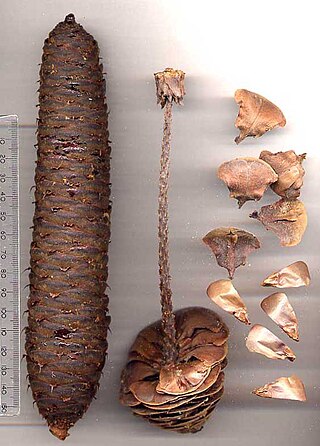
Abies borisii-regis is a species of fir native to the mountains of the Balkan Peninsula in Bulgaria, northern Greece, Kosovo, North Macedonia, Albania and Serbia. It occurs at altitudes of 800–1,800 m, on mountains with an annual rainfall of over 1,000 mm.
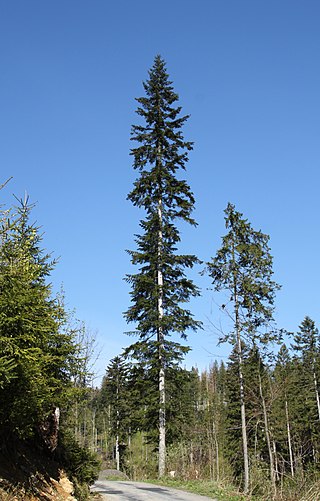
Abies alba, the European silver fir or silver fir, is a fir native to the mountains of Europe, from the Pyrenees north to Normandy, east to the Alps and the Carpathians, Slovakia, Slovenia, Croatia, Bosnia and Herzegovina, Montenegro, Serbia, and south to Italy, Bulgaria, Kosovo, Albania and northern Greece.
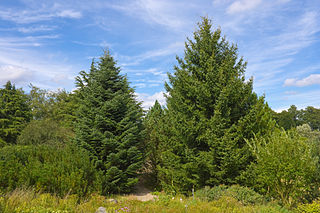
Abies cephalonica or Greek fir is a fir native to the mountains of Greece, primarily in the Peloponnesos and the island of Kefallonia, intergrading with the closely related Bulgarian fir further north in the Pindus mountains of northern Greece. It is a medium-size evergreen coniferous tree growing to 25–35 metres (82–115 ft) – rarely 40 m (130 ft) – tall and with a trunk diameter of up to 1 m. It occurs at altitudes of 900–1,700 m (3,000–5,600 ft), on mountains with a rainfall of over 1,000 millimetres (39 in).

Abies nebrodensis, the Sicilian fir, is a fir native to the Madonie mountains in northern Sicily.

Abies grandis is a fir native to northwestern North America, occurring at altitudes of sea level to 1,700 metres (5,600 ft). It is a major constituent of the Grand Fir/Douglas Fir Ecoregion of the Cascade Range.

Abies concolor, the white fir, concolor fir, or Colorado fir, is a coniferous tree in the pine family Pinaceae. This tree is native to the mountains of western North America, including the Sierra Nevada and southern Rocky Mountains, and into the isolated mountain ranges of southern Arizona, New Mexico, and Northern Mexico. It naturally occurs at elevations between 900 and 3,400 metres.

The blue spruce, also commonly known as green spruce, Colorado spruce, or Colorado blue spruce, is a species of spruce tree native to North America in Arizona, Colorado, Idaho, New Mexico, Utah and Wyoming. It is noted for its blue-green colored needles, and has therefore been used as an ornamental tree in many places far beyond its native range.

The Fraser fir, sometimes spelled Frasier fir, is an endangered species of fir native to the Appalachian Mountains of the Southeastern United States. They are endemic to only seven montane regions in the Appalachian Mountains.

Abies lasiocarpa, the subalpine fir or Rocky Mountain fir, is a western North American fir tree.

The Virgin Mountains are a mountain range of the northeastern Mojave Desert, located in Clark County, southeastern Nevada and Mohave County, northwestern Arizona.

Abies religiosa, the oyamel fir or sacred fir, is a fir native to the mountains of central and southern Mexico and western Guatemala. It grows at high elevations of 2,100–4,100 metres (6,900–13,500 ft) in cloud forests with cool, humid summers and dry winters in most of its habitat regime. In the state of Veracruz, it grows with precipitation all year long. The tree is resistant to regular winter snowfalls.

Abies vejarii is a species of fir native to northeastern Mexico, in the states of Coahuila, Nuevo León, and Tamaulipas, where it grows at high altitudes in the Sierra Madre Oriental.

Epinotia nanana, the European spruce needleminer, is a moth of the family Tortricidae. It is found from northern and central Europe to Russia and Mongolia.
Epinotia rubiginosana is a moth of the family Tortricidae. It is found from Europe to eastern Russia, China, Korea and Japan.
Epinotia trossulana is a moth of the family Tortricidae. It is found in western North America, from British Columbia, south through Utah to California.
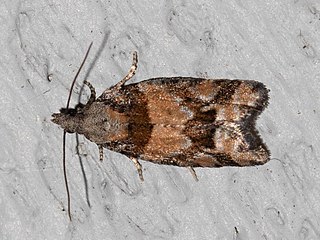
Epinotia radicana, the red-striped needleworm moth, is a species of moth of the family Tortricidae. It is found in western Canada, including British Columbia and Alberta.
Epinotia subsequana, also known as the dark spruce moth, is a species of moth belonging to the family Tortricidae. It was described by the English entomologist, Adrian Hardy Haworth in 1811 and is native to Europe.


















